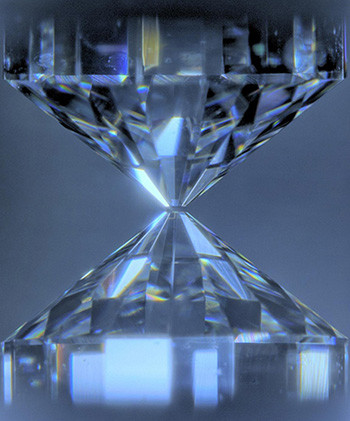The crystals that power Earth's magnetic field

Japanese researchers have been investigating the source of energy driving the Earth’s magnetic field, hidden deep within its core. Their findings, published in the journal Nature, offer insights into the conditions that existed during the formation of the Earth.
In 2013, Kei Hirose, now director of the Earth-Life Science Institute (ELSI) at the Tokyo Institute of Technology, reported that the Earth’s core may have cooled by as much as 1000°C since its formation 4.5 billion years ago. This large amount of cooling would be necessary to sustain the Earth’s geomagnetic field, unless there was another as-yet-undiscovered source of energy. These results created what Peter Olson of Johns Hopkins University referred to as “the New Core Heat Paradox”.
Another unresolved matter was uncertainty about the chemical composition of the core, with Horise explaining, “The core is mostly iron and some nickel, but also contains about 10% of light alloys such as silicon, oxygen, sulfur, carbon, hydrogen and other compounds. We think that many alloys are simultaneously present, but we don’t know the proportion of each candidate element.”
In research recently carried out at ELSI, Hirose and his colleagues used precision-cut diamonds to squeeze tiny dust-sized samples to the same pressures that exist at the Earth’s core. The high temperatures at the interior of the Earth were created by heating samples with a laser beam.
Performing experiments with a range of probable alloy compositions under a variety of conditions, the researchers tried to identify the behaviour of different alloy combinations that match the distinct environment that exists at the Earth’s core. The search began to yield useful results when they began mixing more than one alloy.
“In the past, most research on iron alloys in the core has focused only on the iron and a single alloy,” said Hirose. “But in these experiments we decided to combine two different alloys containing silicon and oxygen, which we strongly believe exist in the core.”
The scientists found that when they examined the samples in an electron microscope, the small amounts of silicon and oxygen in the starting sample had combined together to form silicon dioxide crystals — the same composition as the mineral quartz found at the surface of the Earth. These results prove important for understanding the energetics and evolution of the core.
“We were excited because our calculations showed that crystallisation of silicon dioxide crystals from the core could provide an immense new energy source for powering the Earth’s magnetic field,” said John Hernlund of ELSI, a co-author of the study. Importantly, the additional boost this energy source provides would be enough to solve Olson’s paradox.
The team has also explored the implications of these results for the formation of the Earth and conditions in the early solar system. Crystallisation changes the composition of the core by removing dissolved silicon and oxygen gradually over time. Eventually, the process of crystallisation will stop when then core runs out of its ancient inventory of either silicon or oxygen.
“Even if you have silicon present, you can’t make silicon dioxide crystals without also having some oxygen available,” said ELSI scientist George Helffrich. “But this gives us clues about the original concentration of oxygen and silicon in the core, because only some silicon:oxygen ratios are compatible with this model.”
Colon cancer DNA in blood can guide chemo decisions
A simple blood test could change how doctors decide which patients with colon cancer need...
Non-invasive blood test helps rule out oesophageal cancer
Designed and developed in Australia, the PromarkerEso test is designed to offer a quick,...
Taste-based flu test enables rapid diagnosis
The diagnostic tool consists of the sensor molecule thymol and a virus-specific sugar building...





